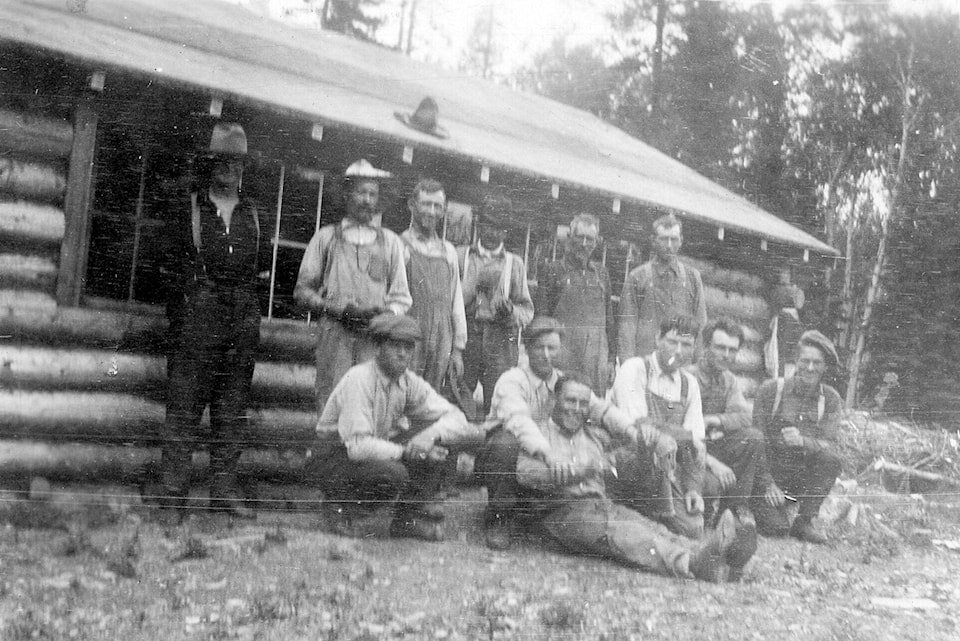Today, Decker Lake Elementary School stands on a hill at the east end of the unincorporated community from which it derives its name, but for most of the last century students living west of Burns Lake attended classes elsewhere.
The area between Piche and Powder House creeks was largely uninhabited in the early 1900s. Most families lived well away from the lake, but there were enough of them to warrant a school, so local volunteers like Fred Saul, his son Charlie, Bill Featherly, Henry Piche, and others built one. The one-room log structure opened in the fall of 1920 with Agnes Donaldson in charge.
Most teachers assigned to the little school stayed with the Piche family. In exchange for a nominal fee, boarders like Donaldson received three meals a day and a chance to share a bed with Pauline Piche, Henry’s wife. (Henry slept on the couch from September to July.) This system, while less than ideal, worked until school district officials sent a male teacher to Decker Lake. They advised the newcomer where he could find room and board but neglected to inform Pauline of the change in staffing. When a young man showed up expecting to share her bed, Pauline, thirty-six at the time, was allegedly so nonplussed that she refused to let him in the building.
By 1923, most of the area’s settlers had relocated closer to the lake, and the old school was a long walk for younger students. Bill Carroll donated land on the south side of the highway across from the Decker Lake Hall, and volunteers built a new school there using blackboards, windows, and other fixtures salvaged from the building’s predecessor.
Palling resident Jean Paulson attended the ‘new’ Decker Lake School. Her parents, Dick and Jessie Carroll, started her early, but not necessarily because they believed she would benefit from the experience. In those days, rural schools had to maintain a minimum enrolment to receive government funding, and Jean’s presence was required to keep the institution open. She walked to and from school each day, a distance of about six miles (9.6 km), from the time she was four years old.
Decker Lake’s second school remained in use until approximately 1939, when enrolment finally exceeded the structure’s occupancy limits. Bill Carroll donated more land, this time west of the Decker Lake Hall on the north side of the highway, and a new wood-frame structure was erected.
The third school in Decker Lake was eventually bolstered by a modern two-room structure several kilometres east along what is now known as McKenna School Road. A veteran teacher named Muriel Mould taught there, and according to at least one of her students, security was never a problem.
“The school,” said Grace Anderson, who attended the McKenna school, “was never locked.”
While the building was more modern in design, its heating system was not. In 1949, School District #55 accepted applications from people interested in becoming the facility’s janitor. The successful candidate, according to an advertisement that appeared in The Review newspaper, would have only two duties: cleaning both classrooms and tending the facility’s wood stoves. The latter must have been an onerous task because according to district officials, the two-room school went through ten cords of dry pine a year.
Getting students to class was also a challenge. The district did not operate a bus system, and instead paid citizens to do the job. To become one of these taxi drivers, according to local officials, you only needed have a Class “A” license and a vehicle large enough to hold more than seven children.
By the 1960s, there were so many families living west of Burns Lake that another school was needed. The provincial government obtained property north of the highway in Decker Lake just west of Piche Creek, and construction got underway in about 1966. Once again, the builders used salvaged materials. In November 1967, the McKenna school was cut in half and moved down Highway 16 to its new home in Decker Lake.
Susan Lightfoot (Lyle) was a naïve twenty-three-year-old when she came to Burns Lake and started teaching at the fifth iteration of Decker Lake School. The experience made an impression on her.
“I remember the teaching conditions,” she recalled years later. “Decker Lake school was just being built, and until its completion about Christmas time, 1967, I taught eighteen Grade Ones in a trailer. The children sat two deep in nine rows. But I don’t remember it as a hardship, just fun. Our staff room was the furnace room of the old two-room school.”
The new school was used for the first time on December 11, 1967, though the portion that had formerly sat on McKenna School Road was not ready until later in the month. School District #55 held the official opening the following year.
The fifth school at Decker Lake celebrated its twenty-fifth anniversary in 1993. Former students and teachers, including the facility’s longest serving staff member, Lori Boychuck, attended the festivities. Boychuck had started teaching at Decker Lake in 1966.
Construction of the current Decker Lake Elementary School got underway in June 2001. More than a thousand dump truck loads of dirt were removed from the site to accommodate the new structure, which opened on December 2, 2002.
(c) 2021 Michael Riis-Christianson and the Lakes District Museum Society
